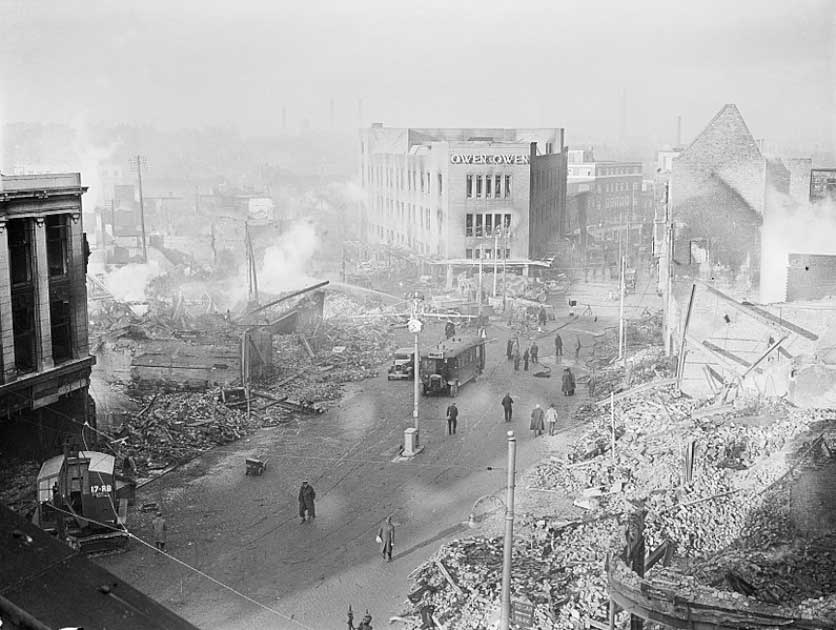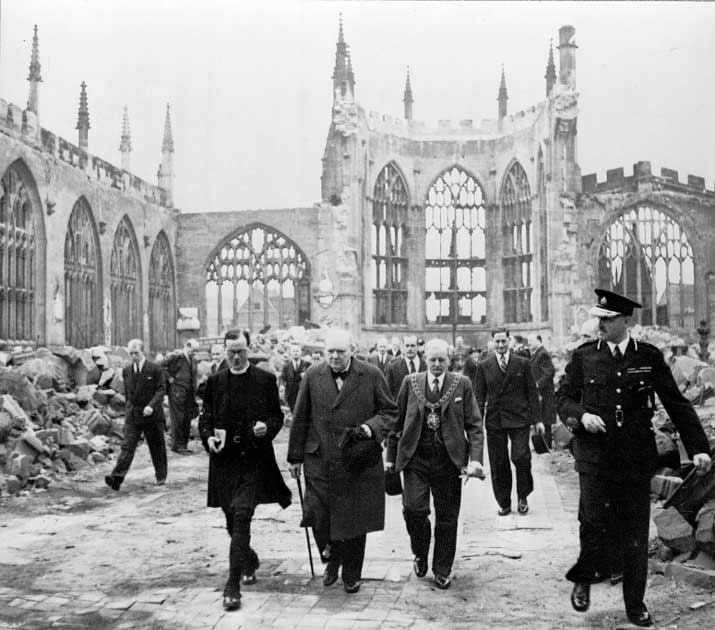Coventry, like many of the cities of the industrial heart of the United Kingdom at the start of the Second World War, was a bustling city of factories, with a center of gothic architecture and a magnificent cathedral. More than 200,000 people lived there, the community anchored by the heavy industries which drove the local economy.
Sadly, Coventry was also a key manufacturer of wartime machinery, parts and munitions, a jewel in Britain’s industrial crown. This made it a legitimate target for Nazi attack, and the city today is very different to the Coventry before the war. The city had been bombed amidst the Battle of Britain in fall 1940, but its inhabitants could never had expected what happened on 14th November.
In one night, the city was reduced to a ruin with a bombardment known as the Coventry Blitz, a bombing campaign so sudden, so ruthless and so thorough that it lasted until well into the following day. In one night, Coventry was destroyed so completely that Goebbels, Hitler’s master of propaganda, later referred to other cities being “Coventried” to describe a particularly vicious and complete destruction.
The population were given no warning and it was a miracle that fewer than 600 people died during the night’s bombing. Wary of air attacks after earlier bombing, much of the population slept outside the city where they were safer.
The city however was a ruin. And Churchill may have known it was coming.
Devastation from the Air
During World War II, Germany launched the most devastating bombing raids on the city of Coventry. A number of sources claim that the wartime prime minister, Winston Churchill was well aware of the attack on the city by the German Luftwaffe. However, he chose to remain silent and do nothing.

Some believe that he did not do anything in order to prevent alerting Adolf Hitler that the Allies had cracked the top-secret Enigma codes of the Nazis. Bletchley Park, home of Churchill’s spybreakers and their intelligence known as Ultra had partially cracked the Nazi encrypted communications, and the information had been invaluable in assisting wartime convoys to reach Britain across the Atlantic.
- The Nazi V-3 Cannon: Could this “Vengeance” Weapon Have Destroyed London?
- Did Germany’s Amerika Bomber Ju 390 Secretly Fly to U.S.?
If the Nazis had realized their communications were compromised, they would have changed the codes and Hitler’s fleet of deadly U-boats would once again have disappeared from Allied sight. Without the supplies brought over the sea to support the British war effort, Britain would have been starved into defeat.
This left Churchill with a dilemma. He had to be very careful in what he did with Ultra intelligence or he risked losing this source of information. And so if he warned Coventry of an attack he knew was coming, the Germans would realize they had a leak. Did he therefore deliberately do nothing?
The German intelligence knew exactly where in the city the military vehicles, navigation aids, and radars were manufactured. They had been targeting Coventry since August in 1940 during the Battle of Britain, bombing the city a total of 17 times and killing 176 people.
But these raids were dwarfed by the attack on the evening of the 14th of November 1940. 515 German bombers who belonged to Luftwaffe 3 and Kampfgruppe 100 launched “Operation Mondscheinsonate” or Operation Moonlight Sonata. The raids mainly intended to destroy the industrial infrastructures and factories in Coventry, to take the city out of the war.
Using a combination of incendiary bombs and high explosives, German strikes on the city were highly precise, guided by earlier marker drops by scout planes. A third of Coventry’s factories were completely destroyed, and another third put out of action.
Coventry city center was also devastated. Almost 4,500 homes were destroyed, and much of the old civic heart of the city was reduced to rubble. The 14th century Coventry Cathedral, seat of the Bishop of Coventry, was reduced to a broken shell.
The heavy use of incendiary bombs started nearly 200 fires in the city, and by morning Coventry was unrecognizable. Ironically, much of the heavy industry the Nazis were trying to cripple had survived, moved out of the city center in earlier years. But the city itself was gone.
The Truth Behind the Coventry Bombing
In the years since the bombing, many sources have suggested that Churchill knew about the bombing attack. On the 12th of November, 1940, two days before the attack, the decryption of the Enigma codes made it clear that there would be a major bombing raid by the Luftwaffe. The code name of the raid was Moonlight Sonata.
However, the decrypts gave the Allies no clue relating to the German bomber’s destination. Based on the latest intelligence, the Air Intelligence report was given to Winston Churchill on the 12th of November, 1940. The potential targets suspected for Moonlight Sonata were London, the Essex Coast, the Thames Valley, or Kent.

A German pilot had been shot down on the 9th of November and captured. Under interrogation, he said that Birmingham and Coventry would be attacked in a huge raid between 15 to 20 November. However, Squadron Leader Humphreys, Bletchley’s senior Air Intelligence Liaison Officer, said that it was definite that the attack would be against London and its Home Countries.
Churchill was given a summary of all these reports, and apparently concluded that the target of Moonlight Sonata would be somewhere in the vicinity of London. Never a man to shy away from personal danger, he returned to the Prime Minister’s residence at Downing Street where, on the evening of the 14th of November, Churchill waited for the attack on London. However, it never started.
Of course, the absolute truth behind who knew what, and when, will likely never come out. But it seems that, in the instance of Coventry, Churchill did not believe the city would be targeted that night. Had he known, would he have warned the city’s people about the devastation headed their way?
We can only hope so.
Top Image: The ruins of Coventry Cathedral, 800 years of history destroyed in a single night (War Office / Public Domain)
By Bipin Dimri